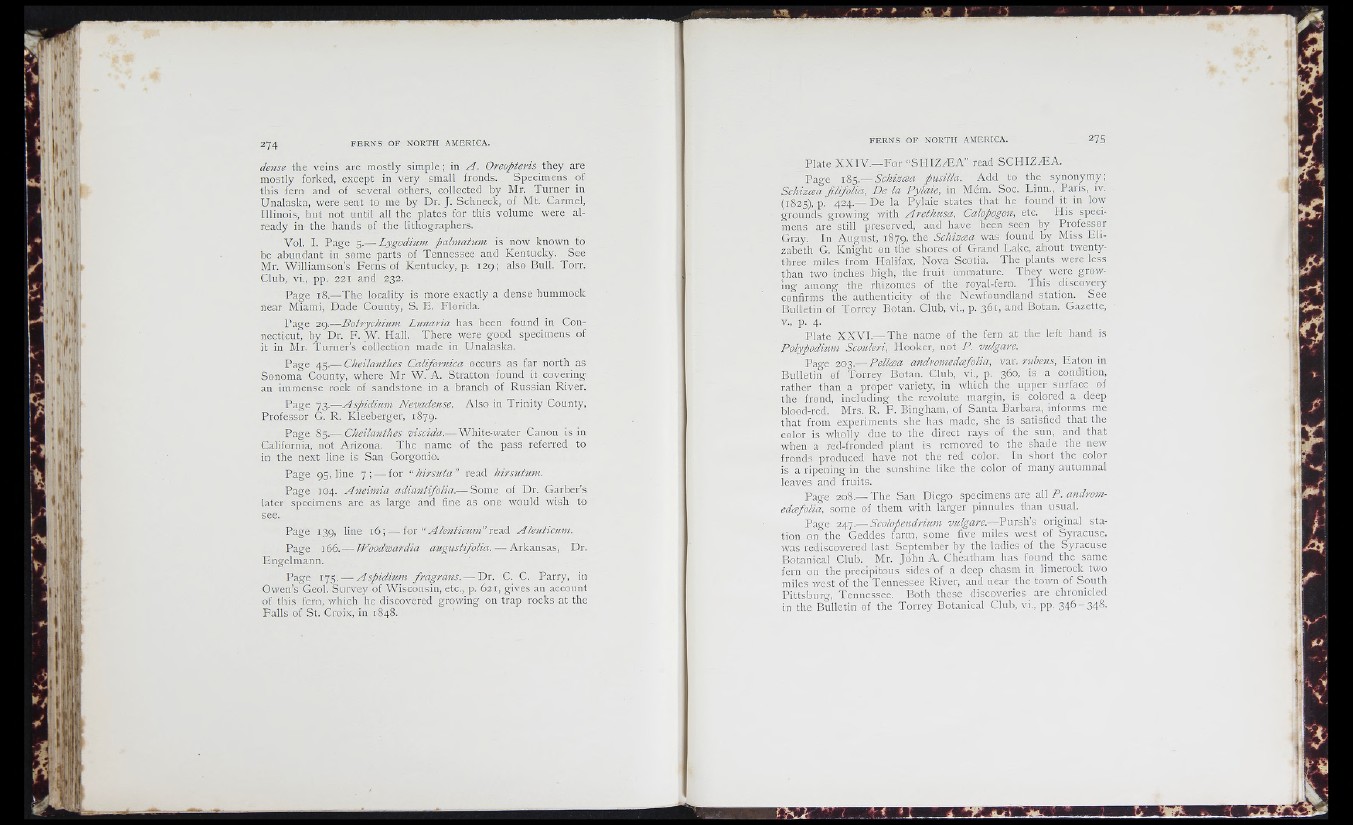
dense the veins are mostly simple; in A . Oreopteris they are
mostly forked, except in very small fronds. Specimens of
this fern and of several others, collected by Mr. Turner in
Unalaska, were sent to me by Dr. J . Schneck, of Mt. Carmel,
Illinois, but not until all the plates for this volume were already
in the hands of the lithographers.
Vol. I. Page 5.— Lygodium palmatum is now known to
be abundant in some parts of Tennessee and Kentucky. See
Mr. Williamson’s Ferns of Kentucky, p. 129; also Bull. Torr.
Club, vi., pp. 221 and 232.
Page 18.—The locality is more exactly a dense hummock
near Miami, Dade County, S. E. Florida.
Page 29.—Botrychium Lunaria has been found in Connecticut,
by Dr. F . W. Hall. There were good specimens of
it in Mr. Turner’s collection made in Unalaska.
Page 45.— Cheilanthes Californica occurs as far north as
Sonoma County, where Mr W. A. Stratton found it covering
an immense rock of sandstone in a branch of Russian River.
Page 73.—Aspidmm Nevadense. Also in Trinity County,
Professor G. R. Kleeberger, 1879.
Page 85.— Cheilanthes viscida.— White-water Canon is in
California, not Arizona. The name of the pass referred to
in the next line is San Gorgonio.
Page 95, line 7 ; — for “ hirsuta" read hirsutum.
Page 104. Aneimia adiantifolia.— Some of Dr. Garber’s
later specimens are as large and fine as one would wish to
see.
Page 139, line 16 ; — ior “ Alenticum” stoA Aleulictim.
Page 166.— Woodwardia augttslfolia. — Arkansas, Dr.
Engelmann.
Page 175. — Aspidium fragrans. — Dr. C. C. Parry, in
Owen’s Geol. Survey of Wisconsin, etc., p. 621, gives an account
of this fern, which he discovered growing on trap rocks at the
Falls of St. Croix, in 1848.
Plate X X IV .—For “SH IZÆ A ” read SCH IZÆ A .
Page l i g -Schizæa pusilla. Add to the synonymy;
Schizcea filfo lia . De la Bylaie, in Mém. Soc. Linn., Paris, iv.
(1825), p. 424.— De la Pylaie states that he found it in low
grounds growing with Arethusa, Calopogon, etc. His specimens
are still preserved, and have been seen by Professor
Gray. In August, 1879, the Schizoea was found by Miss E lizabeth
G. Knight on the shores of Grand I.ake, about twenty-
three miles from Halifax, Nova Scotia. The plants were less
than two inches high, the fruit immature. They^ were growing
among the rhizomes of the royal-fern. Ih is discovery
confirms the authenticity of the Newfoundland station. See
Bulletin of Torrey Botan. Club, vi., p. 361, and Botan. Gazette,
V., p. 4-
Plate X X V I. -T h e name of the fern at the left hand is
Polypodium Scoideri. Hooker, not P . vulgare.
Page 203.— Pellcea andromedcefolia, zez. rubens, Faton in
Bulletin of Torrey Botan. Club, vi., p. 360, is a condition,
rather than a proper variety, in which the upper surface of
the frond, including the revolute margin, is colored a deep
blood-red. Mrs. R. F. Bingham, of Santa Barbara, informs me
that from experiments she has made, she is satisfied that the
color is wholly due to the direct rays of the sun, and that
when a red-fronded plant is removed to the shade the new
fronds produced have not the red color. In short the color
is a ripening in the sunshine like the color of many autumnal
leaves and fruits.
Page 208.— The San Diego specimens are all P. andromedcefolia,
some of them with larger pinnules than usual.
Page zig].— Scolopendrium vidgare.—Pursh's original station
on the Geddes farm, some five miles west of Syracuse,
was rediscovered last September by the ladies of the Syracuse
Botanical Club. Mr. John A. Cheatham has found the same
fern on the precipitous sides of a deep chasm in limerock two
miles west of the Tennessee River, and near the town of South
Pittsburg, Tennessee. Both these discoveries are chronicled
in the Bulletin of the Torrey Botanical Club, vi., pp. 346 -348.